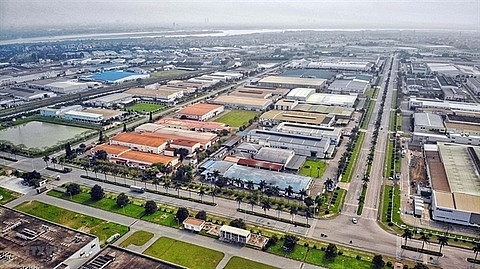Large industrial zones set up to attract FDI
 |
| The positive growth prospect of the Vietnamese economy after the pandemic attracted investors and created conditions for the industrial real estate market to be robust in the first months of this year. - VNA/VNS Photo |
VSIP Group, at the end of March, started the construction of the VSIP 3 Industrial Zone, which covered more than 1,000 hectares in Hoi Nghia Commune, Tan Uyen Town and Tan Lap Commune, Bac Tan Uyen District, Binh Duong Province
To date, the industrial zone attracted more than 30 companies, both domestic and foreign, to study the production opportunity, with an expected total investment of around US$1.8 billion.
Recently, the Dai An Urban – Industrial Zone Development Corporation Joint Stock Company and Indian partners signed a cooperation agreement for developing a 960-hectare pharmaceutical park project worth around $10-12 billion in Hai Duong Province.
The park was expected to be where famous pharmaceutical companies in the world gathered for research and production.
Saigon Telecom Technology Joint Stock Company (Saigontel) and VinaCapital signed a memorandum of understanding with Singapore – based Aurous about cooperation in investing in a 700-ha urban–industry complex in Bac Giang with an estimated investment of around $2.5 billion.
According to SSI Research, the demand for hiring industrial land will be strong this year, fuelled by a production shift to Viet Nam together with the completion of infrastructure projects such as Bien Hoa – Vung Tau, Dau Giay – Phan Thiet, North-South expressways, Thi Vai – Cai Mep and Gemalink ports.
SSI Research forecast that industrial land rents in Viet Nam would increase by 8-9 per cent in the Southern region and 6-8 per cent in the North this year due to a scarcity of supply amid the rising demand.
Su Ngoc Khuong, senior director of Savills Viet Nam, said that the positive growth prospect of the Vietnamese economy after the pandemic attracted investors and created conditions for the industrial real estate market to be robust in the first months of this year.
To attract multinational corporations, Viet Nam needed to develop not only large-scale industrial parks but also the transportation and logistics infrastructure systems and hasten administrative reforms to improve the investment climate, Khuong said.
Localities and Vietnamese firms need to prepare high-quality human resources, especially for hi-tech industries, to meet the demand of multinational corporations, an important factor to attract them, as the Government prioritises attracting investment in hi-tech industries, not labour-intensive.
According to David Jackson, CEO of Colliers Viet Nam, Viet Nam needed to renew the industrial park development model to build eco-industrial parks.
This model would play an important role in the sustainable development strategy, reducing resource exploitation and limiting the impact on the environment but not affecting the performance of businesses, adding that this model would also contribute to the countries and global effort to combat climate change.
Specific steps to be taken were to improve the technology transfer capacity of enterprises, apply advanced technologies and minimise emissions, he added.
He said that industrial zones should enhance linkage to develop production and logistics chains to improve competitiveness, lower production costs and increase sustainability.
What the stars mean:
★ Poor ★ ★ Promising ★★★ Good ★★★★ Very good ★★★★★ Exceptional
Related Contents
Latest News
More News
- Sun Group breaks ground on $2 billion Van Don casino complex (December 19, 2025 | 18:14)
- Rare, beautiful, sustainable: the mark of iconic real estate (December 19, 2025 | 08:00)
- Owner-occupied housing stabilises, paving the way for new growth cycle (December 18, 2025 | 17:04)
- Unlocking urban potential of smart cities (December 18, 2025 | 16:50)
- Green finance offers 'passport' for Vietnamese construction, building materials firms (December 15, 2025 | 08:00)
- Gamuda Land commit long-term investment (December 12, 2025 | 11:49)
- HITC ties up with Evolution to develop AI and hyperscale data centres in Vietnam (December 11, 2025 | 12:09)
- Real estate deals boom via high-profile names (December 08, 2025 | 11:32)
- Industrial segment shaped by M&As (December 08, 2025 | 08:00)
- The Privé sets the benchmark for luxury real estate (December 05, 2025 | 08:28)

 Tag:
Tag:





















 Mobile Version
Mobile Version